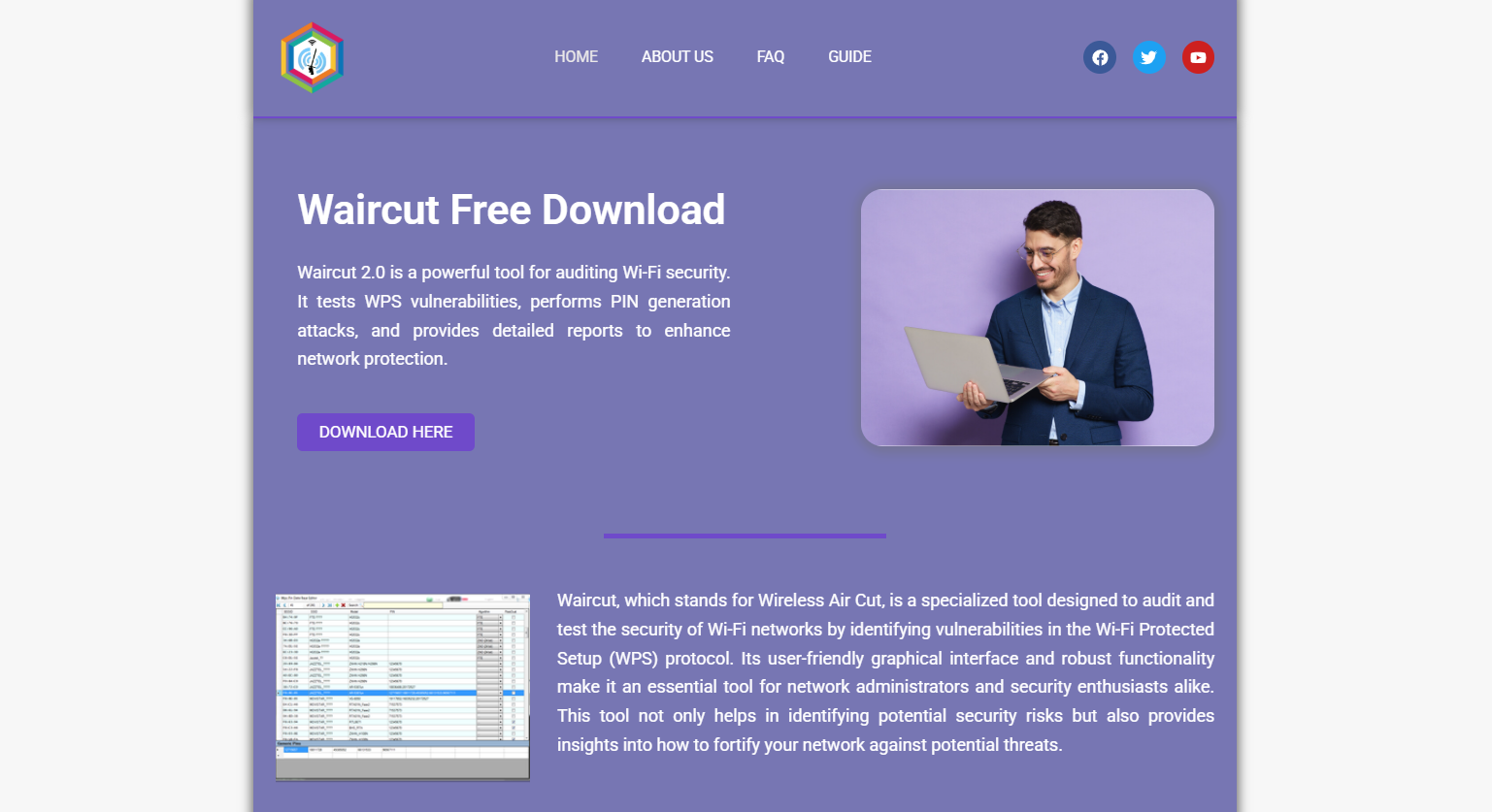Network security has become a top priority in an increasingly digital world where sensitive data, financial transactions, and private communications pass through wireless networks daily. Tools that evaluate and fortify these networks are essential for preventing unauthorized access and cyberattacks. Among such tools, Waircut (Wireless Air Cut) stands out as a powerful, open-source solution designed to test and improve the security of Wi-Fi networks. Originally developed to assess vulnerabilities related to the WPS (Wi-Fi Protected Setup) protocol, Waircut has grown in popularity among ethical hackers, penetration testers, and cybersecurity professionals for its accuracy and effectiveness.
This article explores how Waircut contributes to enhancing network safety by uncovering security weaknesses, supporting responsible network audits, and promoting the development of stronger Wi-Fi infrastructure.
Understanding the Role of Waircut
Waircut is a Windows-based wireless security auditing tool that tests the robustness of wireless networks, particularly those with WPS enabled. WPS is a network security standard designed to simplify the connection of devices to a wireless network. Unfortunately, many WPS implementations are vulnerable to brute-force attacks, allowing attackers to gain unauthorized access.
Waircut operates by launching a series of penetration tests using various WPS PINs against a wireless access point. It integrates with tools such as JumpStart and Reaver (via a Linux subsystem or compatibility layers) to identify vulnerable routers. The software is valuable for network administrators and IT professionals who need to evaluate their own networks and rectify any security flaws before malicious actors exploit them.
Identifying Weaknesses in WPS
The central purpose of Waircut revolves around identifying weaknesses in the WPS protocol. Many routers ship with WPS enabled by default, often using weak or predictable PINs that can be brute-forced. These PINs, usually 8-digit codes, can be cracked with sufficient time and computing power.
Waircut uses preloaded WPS PIN databases and algorithms to conduct such tests efficiently. It identifies routers susceptible to these attacks and notifies the user of the vulnerability. This early warning is critical. Once aware of the problem, users or administrators can disable WPS or update their router firmware, thereby eliminating a significant security hole.
The simplicity of this process allows even those with moderate technical expertise to perform essential security audits on their networks, helping reduce the overall risk of unauthorized access.
Supporting Ethical Hacking and Network Defense
Ethical hacking has emerged as a cornerstone of modern cybersecurity strategy. By simulating attacks on their own systems, organizations can uncover vulnerabilities and address them before real attackers strike. Waircut fits perfectly into this paradigm by offering a safe, controlled environment for testing Wi-Fi security.
Cybersecurity professionals can use Waircut to assess not only personal or organizational networks but also to educate others on the importance of Wi-Fi safety. Training sessions and workshops often incorporate tools like Waircut to demonstrate real-world vulnerabilities in wireless setups. This practical exposure equips users with the knowledge and skills required to protect their digital environments effectively.
Unlike black-hat tools designed for exploitation, Waircut encourages responsible use. It’s a reminder that network security isn’t just about firewalls and antivirus software—it begins with a robust, well-tested wireless infrastructure.
Educating Users About Router Configuration
Most residential users rely on default settings when configuring their routers. Unfortunately, this includes leaving WPS enabled, using default passwords, and neglecting firmware updates—all of which open doors to intrusions. Waircut plays a vital role in educating users about these risks.
After conducting tests, Waircut presents results that inform users about vulnerabilities in an understandable format. These reports may seem technical at first, but actionable recommendations are often included. For example, if a router is found vulnerable to WPS PIN brute-forcing, users are advised to disable WPS or switch to WPA2/WPA3 with a strong passphrase.
This form of awareness-building is crucial in reducing the attack surface in home networks. As IoT devices become more common—smart cameras, thermostats, speakers, and appliances—secure routers form the backbone of safe digital ecosystems.
Integrating with Broader Security Tools
Waircut does not function in isolation. Its effectiveness is amplified when integrated into a broader toolkit for network analysis and penetration testing. Tools such as Wireshark (for packet inspection), Aircrack-ng (for wireless network cracking), and Nmap (for scanning) can be used alongside Waircut to develop a complete understanding of network status.
For instance, a security expert might first use Nmap to identify devices on a network, then deploy Waircut to test WPS vulnerabilities, followed by Aircrack-ng to evaluate WPA handshake robustness. In this workflow, Waircut adds a focused, valuable perspective by targeting a specific yet common vulnerability.
This versatility reinforces Waircut’s value. It’s not a generalist tool but a specialist one—designed to address a targeted weakness with precision and depth. This makes it indispensable for professionals conducting in-depth security assessments.
Strengthening Organizational Policies
Beyond individual users, organizations with large-scale Wi-Fi deployments must take network safety seriously. Whether in corporate offices, universities, or healthcare facilities, unsecured wireless networks can lead to data breaches, legal liabilities, and reputational damage.
Waircut enables IT departments to scan and verify every access point across campuses or buildings. By identifying WPS-enabled routers and ensuring their configurations meet internal security standards, organizations can maintain compliance and reduce risk.
Furthermore, documenting Waircut scan results as part of internal audit trails ensures traceability. These records can be used to demonstrate due diligence in network security—useful during compliance checks, insurance reviews, or internal assessments.
Encouraging Firmware Updates and Vendor Accountability
One of the less-discussed benefits of using Waircut is its role in pushing vendors toward accountability. When users detect and report vulnerabilities in routers—often through responsible disclosure channels—it motivates manufacturers to release firmware patches.
Security researchers frequently use Waircut to identify flaws in devices, particularly legacy or low-cost routers that may have neglected WPS vulnerabilities. These findings contribute to broader security awareness across the industry.
Waircut’s very existence pressures router manufacturers to adopt stronger default configurations, better encryption protocols, and clearer user controls. As the tool becomes more widespread, so does the call for better standards in wireless hardware.
Building Habits for Proactive Security
One of the challenges in cybersecurity is the tendency of users to be reactive—addressing problems only after a breach occurs. Tools like Waircut foster a more proactive mindset. By routinely scanning Wi-Fi networks and correcting issues before they can be exploited, users take a preventative approach to security.
This shift is important. Network safety is not a one-time task but a continuous responsibility. The simplicity and accessibility of Waircut make it ideal for routine use, encouraging habits that align with best practices in digital hygiene.
Advantages of Open-Source Accessibility
Waircut’s open-source nature is a critical advantage. Unlike proprietary software that may have hidden limitations or licensing costs, Waircut is free to download, modify, and redistribute. This ensures transparency, peer review, and rapid development.
Open-source projects benefit from community involvement. Developers can suggest improvements, patch bugs, or adapt Waircut to new environments. This community-driven model leads to more secure and reliable software over time, as a broader pool of talent contributes to the project’s success.
Additionally, it democratizes security tools. From students to cybersecurity veterans, anyone with basic knowledge can utilize Waircut without cost barriers, helping spread essential security practices across more demographics and geographies.
Addressing Common Misconceptions
There’s a persistent myth that tools like Waircut are only used for malicious purposes. In truth, any technology can be misused—but the intent and context of usage define its ethical standing. Waircut was developed for legitimate testing and learning, not exploitation.
When used properly, Waircut is a protective tool. It doesn’t create vulnerabilities; it uncovers existing ones. By highlighting the gaps in a network’s defense, it empowers users to close them. This distinction is important, especially when discussing cybersecurity with clients, organizations, or educators.
Fostering understanding around ethical tool usage helps reduce fear and misinformation. It also builds trust in the security community by demonstrating that strong tools can coexist with responsible practices.
Future Outlook and Evolving Standards
As wireless technology evolves, so too will the threats that target it. Protocols like WPA3 are being adopted to replace older, weaker standards. However, adoption is slow, and many networks still rely on outdated security measures, including WPS.
Waircut’s role remains important during this transition. It helps identify vulnerable legacy systems and encourages faster adoption of modern standards. In the future, tools like Waircut may expand to test newer protocols or integrate artificial intelligence for smarter vulnerability detection.
By staying relevant and adaptable, Waircut can continue to serve as a vital resource in the shifting landscape of wireless security.
Conclusion
Waircut plays a vital role in enhancing network security by providing a targeted, efficient, and accessible solution for testing wireless vulnerabilities, particularly those associated with WPS. Its use promotes ethical hacking, fosters user education, and supports robust cybersecurity practices across personal and organizational environments.
By helping users identify and fix weak spots in their Wi-Fi configurations, Waircut reduces the risk of unauthorized access, data breaches, and cyber threats. As digital infrastructure becomes more complex and interconnected, the need for reliable tools like Waircut will only grow.







